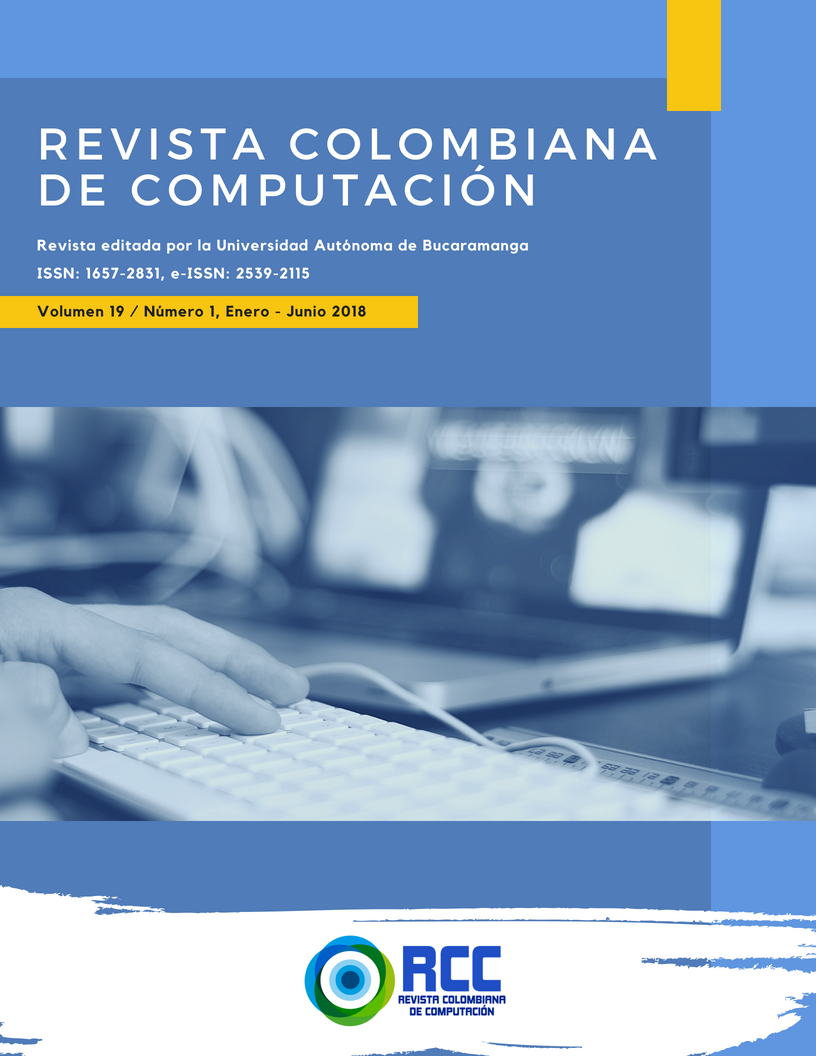Juego serio para entrenar habilidades auditivas en niños con discapacidad auditiva
Resumen
En este trabajo se presenta el diseño de un juego serio, cuyo objetivo es ejercitar la identificación y la discriminación auditiva en niños con discapacidades auditivas, tanto en aquellos que utilizan implantes cocleares como audífonos. En el diseño se han tenido en cuenta aspectos de diseño emocional, metodologías de desarrollo de juegos serios y las actividades que llevan a cabo los educadores con los niños para trabajar estas habilidades auditivas.
Referencias bibliográficas
[2] V. M. Peñeñory, C. Manresa-Yee, I. Riquelme, C. A. Collazos, H. M. Fardoun, and D. M. Alghazzawi, “Review of systems to train psychomotor skills in hearing impaired children,” in Proc. 4th Workshop on ICTS for improving patients rehabilitation research techniques, 2016, pp. 81-84.
[3] National Institute on Deafness and other Communication disorders, “Implantes cocleares". Disponible en: https://www.nidcd.nih.gov/es/espanol/implantes-cocleares. [Accedido: Feb. 2017].
[4] National Institute on Deafness and other Communication disorders, “Audífonos". Disponible en: https://www.nidcd.nih.gov/es/espanol/audifonos. [Accedido: Feb. 2017].
[5] G. González, “Logopedia Escolar Digitalizada. Informe Series Desarrollo, transferencia y difusión social de la investigación en TIC para la Educación". Ministerio de Educación, Políticasocial y deporte. Instituto Superior de Formación y Recursos en Red para el Profesora.
[6] ASPAS Mallorca, “Fases del entrenamiento auditivo". Disponible en: http://www.aspasleehablacomunica.com/fases-del-entrenamiento-auditivo/. [Accedido: 01/12/2017].
[7] D. Norman, Emotional Design: Why We Love (or Hate) Everyday Things. 2004.
[8] G. N. Yannakakis, K. Karpouzis, A. Paiva, and E. Hudlicka, “Emotion in Games,” in Affective Computing and Intelligent Interaction: Fourth International Conference, ACII 2011, Memphis, TN, USA, October 9--12, 2011, Proceedings, Part II, S. D’Mello, A. Graesser, B. Schuller, and J.-C. Martin, Eds. Berlin, Heidelberg: Springer Berlin Heidelberg, 2011, p. 497.
[9] P. A. Schutz and R. Pekrun, Chapter 1 - Introduction to Emotion in Education. Burlington: Academic Press, 2007.
[10] T. Bentley, L. Johnston, and K. von Baggo, “Evaluation Using Cued-recall Debrief to Elicit Information About a User’s Affective Experiences,” in Proceedings of the 17th Australia Conference on Computer-Human Interaction: Citizens Online: Considerations for Today and the Future, 2005, pp. 1-10.
[11] D. A. Norman, A. Ortony, and D. M. Russell, “Affect and machine design: Lessons for the development of autonomous machines,” IBM Syst. J., vol. 42, no. 1, pp. 38-44, 2003.
[12] D. Norman and A. Ortony, “Designers and Users: Two Perspectives on Emotion and Design,” in Proc. of the Symposium on “Foundations of Interaction Design” at the Interaction Design Institut, 2003.
[13] B. Reeves and J. . Read, Total Engagement: Using Games and Virtual Worlds to Change the Way People Work and Businesses Compete. Harvard Business School Press, 2009.
[14] G. Zichermann and C. Cunningham, Gamification by Design. O’Reilly Media, Inc., 2011.
[15] S. Deterding, D. Dixon, R. Khaled, and L. Nacke, “From Game Design Elements to Gamefulness: Defining ‘Gamification,’” in Proceedings of the 15th International Academic MindTrek Conference: Envisioning Future Media Environments, 2011, pp. 9-15.
[16] A. F. S. Barbosa, P. N. M. Pereira, J. A. F. F. Dias, and F. G. M. Silva, “A New Methodology of Design and Development of Serious Games,” Int. J. Comput. Games Technol., vol. 2014, no. Article ID 817167, p. 8 pages, 2014.
[17] I. Marfisi-Schottman, S. George, and F. Tarpin-Bernard, “Tools and Methods for Efficiently Designing Serious Games",” in 4th Europeen Conference on Games Based Learning ECGBL2010, Copenhagen, Denmark, 21-22 October 2010, 2010, pp. 226-234.
[18] B. Marne, J. Wisdom, B. Huynh-Kim-Bang, and J.-M. Labat, “The Six Facets of Serious Game Design: A Methodology Enhanced by Our Design Pattern Library,” in 21st Century Learning for 21st Century Skills: 7th European Conference of Technology Enhanced Learning, EC-TEL 2012, Saarbr{ü}cken, Germany, September 18-21, 2012. Proceedings, A. Ravenscroft, S. Lindstaedt, C. D. Kloos, and D. Hernández-Leo, Eds. Berlin, Heidelberg: Springer Berlin Heidelberg, 2012, pp. 208-221.
[19] R. Prieto de Lope, N. Medina-Medina, P. Paderewski, and F. L. Gutiérrez Vela, “Design Methodology for Educational Games based on Interactive Screenplays.,” in CoSECivi, 2015, vol. 1394, pp. 90-101.
[20] S. Cano, J. M. Arteaga, C. A. Collazos, C. S. Gonzalez, and S. Zapata, “Toward a methodology for serious games design for children with auditory impairments,” IEEE Lat. Am. Trans., vol. 14, no. 5, pp. 2511-2521, May 2016.
[21] S. Cano, C. A. Collazos, C. Manresa-Yee, and V. Peñeñory, “Principles of Design for Serious Games to Teaching of Literacy for Children with Hearing Disabilities,” in Proceedings of the XVII International Conference on Human Computer Interaction, 2016, p. 6:1-6:2.
[22] S. Cano, V. Peñeñory, C. A. Collazos, H. M. Fardoun, and D. M. Alghazzawi, “Training with Phonak: Serious Game As Support in Auditory -- Verbal Therapy for Children with Cochlear Implants,” in Proceedings of the 3rd 2015 Workshop on ICTs for Improving Patients Rehabilitation Research Techniques, 2015, pp. 22-25.
[23] S. Cano, L. Galvez, P. Giraldo, C. Collazos, and H. Fardaun, “Sistema interactivo para la enseñanza de la lectoescritura para niños con implante coclear,” Rev. Iberoam. Inform. Educ., no. 4, pp. 21-29, 2016.
[24] V. M. Peñeñory, C. Manresa-Yee, C. A. Collazos, S. Cano, and H. M. Fardoun, “Propuesta de modelo para el análisis de requisitos y actividades para el diseño de experiencias interactivas dirigidas a la rehabilitación psicomotriz de niños con discapacidad auditiva,” in 18th International Conference on Human Computer Interaction, Cancun, Quintana roo MEXICO, September 2017 (Interaccion’17)(México, 25-27 September 2017), 2017.
[25] C. Yi and T. Kim, “Serious Game Design for Auditory Training of HearingImpaired Children,” TechArt J. Arts Imaging Sci., vol. 2, no. 1, pp. 46-51, 2015.
[26] A. Alamoudi, M. Almozaini, R. Alabdulrahman, S. Alkoblan, S. Drine, and A. Al-Wabil, “Interactive Serious Gaming for Children with Auditory Processing Difficulties in the Arabic Language,” in HCI International 2013 - Posters’ Extended Abstracts: International Conference, HCI International 2013, Las Vegas, NV, USA, July 21-26, 2013, Proceedings, Part I, C. Stephanidis, Ed. Berlin, Heidelberg: Springer Berlin Heidelberg, 2013, pp. 188-191.
[27] N. Fullana Rivera, “Age-related effects on the acquisition of a foreign language phonology in a formal setting. Appendix A,” Universitat de Barcelona, 2006.
[28] K. B. Agung, S. C. Purdy, and C. Kitamura, “The Ling Sound Test Revisited,” Aust. New Zeal. J. Audiol., vol. 27, no. 1, pp. 33-41, 2005.
[29] ISO 9241-210:2010, “Ergonomics of human-system interaction - Part 210: human-centred design for interactive systems,” Int. Organ. Stand., 2010.
[30] K. Dorst, “The core of ‘design thinking’ and its application,” Des. Stud., vol. 32, no. 6, pp. 521-532, Nov. 2011.
[31] “Fonomágica". Disponible en: http://www.fonomagica.co. [Accedido: Marzo 2017].













